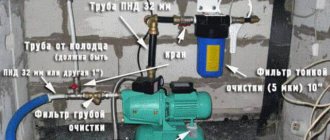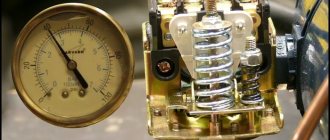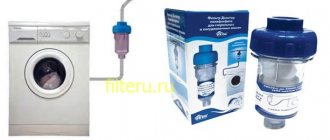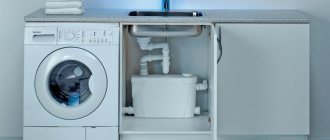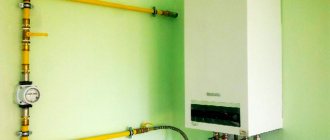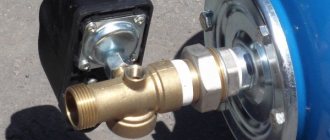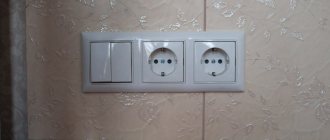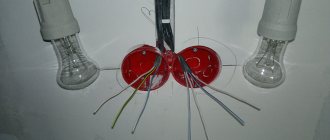In autonomous water supply and heating systems of private houses, the presence of a pumping station is mandatory.
It should be capable of automatically adjusting the parameters of the output water flow.
The requirements for reliability, operating parameters and range of operating conditions may be different.
Those who are planning to build such a system should pay attention to Jumbo pumps, in particular, those equipped with an automation unit, Jumbo 60/35 P-24 stations manufactured by Gilex.
Operating principle and design of Jumbo pumping stations
To understand the operating principle of Gilex Jumbo pumping equipment, you should understand its structure. The station has several main nodes:
- hydraulic accumulator, also known as a storage membrane tank, with a capacity of 24 liters or more;
- water pump, for more productive models with a remote ejector;
- a relay that responds to pressure changes in the tank;
- pressure gauge
The pump impeller is always made of durable polymer that is resistant to the mechanical effects of abrasives. The equipment body is made of cast iron (marked with the letter “C” in the name of the device), glass-filled polypropylene (marked “P”) or stainless steel (“N”). The hydraulic accumulator is produced only in steel version.
The pumping station operates according to this principle:
- in the initially filled tank, the pressure is at its maximum;
- as soon as the water supply tap in the house is opened, the liquid leaves the tank through the pipes and enters the plumbing points of the cottage;
- at the same moment, the pressure of the accumulator drops, which leads to the pump turning on;
- the unit pumps water into the tank until the pressure again reaches the set permissible value.
The system always has a sufficient supply of liquid for optimal pressure. The station's operating cycles are repeated.
Gilex water jet, repair of submersible pump 60/32, replacement of capacitor
The other day, an acquaintance brought a submersible pump for repair, model - Gilex 60/32, when I asked why he didn’t contact the repair service, he received the answer - he did, but the service said that the motor was faulty and for repairs they charged an amount commensurate with the cost of a new one pump
The Gilex borehole pump is quite reliable and easy to use, it does not make noise or rattle, you lower it into the well and only control its operation by the water pressure in the tap; as a rule, the warranty period for pumps made in Russia lasts in full, for similar products from the Middle Kingdom, I can’t say anything because I haven’t used it.
But as you know, nothing lasts forever under the sun, so this device has its own “weak link”, this is the starting capacitor, which is also the working capacitor SSV 60 16 uF / 450 V, this is what this handsome man looks like,
starting capacitor
Naturally, a new pump was purchased and installed, and I was “pulled up,” so to speak, as an expert - to establish the true malfunction, I, of course, agreed, and at the same time decided to collect material for this note, and so let’s move directly to the repair process.
Do-it-yourself repair, sequence
What to do if the pump hums, but does not pump water, this is a fairly frequently asked question, and today I will tell you how to solve this problem yourself. It also happens that the pump does not show any signs of “life,” but after replacing the capacitor it works properly, of course, if no other faults.
First of all, when you find that water from the well does not flow into the house, we try to apply voltage to the pump directly, bypassing the automation, for example, remove the cap from the well, disconnect the wires going to the terminal box from the pump and plug them into the socket, if the pump after that it didn’t work, which means it’s the reason and you need to take it out of the well for inspection.
Purely from experience, there are two main reasons why the pump hums but does not pump water - the starting capacitor is faulty and the pump is clogged with sand, clay or something else; unscrew the lower part of the housing to make it easier to unscrew; use a car oil filter wrench, but first clamp it the opposite side of the housing in a vice behind the water line flange.
car oil filter wrenches
Carefully remove the working rings - impellers (impellers) from the shaft, carefully, effortlessly try to turn the shaft by hand, if it rotates freely, then there are no blockages, jamming, and so on.
We supply power to the pump again, try to turn the shaft, and in this way help the pump start; if the pump starts, then the problem was in the starting capacitor, this is also valid for other models of similar pump designs.
The capacitor is located in the upper part of the pump, in order to get to it you need to very carefully, through some kind of attachment or with a non-metal hammer, lightly hit the flange, and move the motor in the pump housing.
Next, in a vertical position, shake the pump so that the engine returns to its original position, and then pull out the o-ring from the shaft side and remove the engine from the housing.
Gilex water jet pump disassembled
Then, as in the previous case, fix the motor housing in a vice by the flange and sway from side to side, open the motor housing, this is where this very capacitor is located.
In our case, the fact that the capacitor has failed is beyond doubt, since traces of mechanical destruction of the housing are visible, we replace it with a similar one and try to start the pump, everything worked fine, if in doubt, then to check, lower the pump into a container of water and make sure , so to speak clearly.
The problem is solved; we assemble the pump in the reverse order, carefully inspect the working rings - impellers for wear, often due to the high sand content in the water, which breaks the hexagonal mounting holes (on the shaft), and they become round or elliptical, in this case, pumping water through this step will not happen.
faulty capacitor in the pump motor
To illustrate the process of disassembling the pump, watch a short video; the quality of the video is poor, but I’m posting what was at the time of writing.
Model range and technical characteristics
All Jumbo pumping equipment from Gilex are labeled in such a way that the user can deduce from the name the main capabilities of the unit. For example, the name of the station NS Jumbo 70/50 N-24 will be deciphered as follows:
- NS - pumping station;
- 70 — unit productivity (l/min);
- 50 - pressure - the maximum distance the unit can transport water, calculated in meters;
- N - body material, in this case stainless steel;
- 24 - volume of the hydraulic accumulator (in liters).
There are several models of Gilex Jumbo pumping stations on the market. With the same technical characteristics, the housings can be made of different materials (steel, cast iron, polymer).
Station Gilex Jumbo 50/28
This model has the following technical characteristics:
- productivity - 50 l/min;
- head - 28 m;
- tank volume - 24 l;
- power - 500 W;
- possibility of transporting water from a depth of up to 9 m.
This station is the best option for a small summer cottage or a family of 2-3 people.
NS Jumbo 60/35
Features of this model according to the instructions:
- temperature of pumped water - +1-+50 degrees;
- productivity - 60 liters per minute;
- head - 35 m;
- permissible depth of liquid intake - 9 m;
- power - 600 W.
The approximate price of the Jumbo 60/35 model is about 8,500 rubles.
Jumbo Station 70/50
Here the unit is more powerful and productive. Its technical characteristics:
- power - 1100 W;
- productivity - 70 l/min;
- head - 50 m;
- tank volume - 24 l.
All models of Jumbo pumping stations are equipped with a soft start system and protection against dry running (combustion). Automatic control of the unit simplifies its operation.
Decoding the markings of various models
Marking of water pump models Vodomet.
Pumping mechanisms are available in several modifications; you can choose a unit with characteristics suitable for both domestic needs and industrial purposes. Design features are reflected in the markings of the models.
Example of designation: “Water cannon” 55/35, where
- "Water cannon" - serial name;
- the number 55 indicates the maximum water flow, indicated in l/min;
- 35 - highest pressure.
The marking may contain additional letter designations:
- “A” - the pump is equipped with a float switch;
- “BK” - a unit with a 1 m long cable without an electrical plug;
- "PROF" - pump without an automatic shut-off mechanism;
- “M” - main unit;
- “HOUSE” - for automatic water supply systems in private homes;
- “Ch” - automatic control mechanism;
- “DF” - with a bottom filter.
How to choose a station for a country house
Gilex Jumbo 50/28 in a cast iron body
In order for pumping equipment to work as efficiently as possible (do not overuse electricity and supply the optimal volume of water), when choosing it, you need to rely on the following criteria:
- Performance. Determined by the number of plumbing points in the house and the number of people living in it. In this case, the productivity of the unit should not be greater than the flow rate of the water intake source. Otherwise, the station will shut down due to the danger of dry running.
- Storage tank volume. For a family of two people, it is enough to take a hydraulic accumulator with a capacity of 24 liters. For 3-5 people living in a house, a volume of 50 liters is already needed, and so on.
- Station pressure. It is calculated simply - the vertical distance from the unit to the highest plumbing point + 1/10 of the total horizontal length of the pipeline + tap pressure (from 4 to 10 m).
- Case material. Here you need to rely on the future operating conditions of the equipment. Steel and cast iron are suitable for more “field” ones. The polymer will be cheaper, but it is better to use it in a warm room.
- Equipment power. It must correspond to the family’s ability to pay for utilities with optimal technical characteristics of the station.
If water will be taken from a depth of more than 10 m, it is worth taking equipment with a remote ejector.
How does Vodomet work?
The design of the centrifugal pump “Vodomet” is somewhat more complicated than that of the vibrating “Malysh” or “Rucheyok”. At the bottom of the unit there is a sealed oil-filled engine, on the shaft of which unique cups are placed - elements with floating working wheels.
Depending on the power of the pump, there may be more or fewer such glasses. The top cover of the pump presses against all these elements and keeps them in the correct position. From this cover comes an electrical cable, a pipe for supplying water to the water main and eyelets for hanging the pump.
The Vodomet pump is a reliable technology with high efficiency. Its design allows you to perform many repairs at home
Floating impellers are the highlight of this unit. At the very beginning of work, they are ground into the structure by grinding off the plastic collar. As a result, a minimum gap is formed between the static and moving elements of the device. This design ensures high pump efficiency.
Another advantage of floating pump wheels is the ability to pass sand particles that fall into the well during natural sanding processes. Models of the “Water Jet A” type pump are designed in a similar way.
They are additionally equipped with a float switch, which is designed to turn off the device in the event of an emergency. For example, if the water in the source has dried up for some reason (low flow, flooding, etc.).
If the installation and operation of the Vodomet pump were carried out in accordance with the manufacturer’s recommendations, there will be no need for premature repairs
The “Vodomet” borehole pump, despite the lack of such protection, works quite well, but it is very important to install it correctly in the well. It can be turned on/off every three minutes without compromising the integrity of the structure
To prevent a “dry running” situation, which is detrimental to any pump, you should choose the right model, hang it at the right height, etc.
An additional element extends the life of the device, but requires additional space for placement. For this reason, Vodomet A” is usually used not in wells, but in wells. But this model has to be repaired in approximately the same way as a well pump.
Another feature of the Vodomet submersible pumps is the lower water intake. The design allows the pump to be used in a semi-submerged state. If you need to completely empty the container, the “Water Cannon” will do the job perfectly.
But placing a pump in a filter well in this way is not always useful. The device will constantly pick up sand from the bottom. This negatively affects both the quality of the water and the condition of the impellers of the device.
To prevent a problem of this nature, homemade nozzles are placed on the bottom of the pump to prevent sand from penetrating into the device.
The unit must be positioned in the well so that there is at least 1 m between the bottom of the excavation and the bottom of the pump. The Water Cannon can be immersed so that there is no more than 30 m between the water surface and the top of the device.
The water jet is designed for pumping water with temperatures from +1 to +35 °C. It is not recommended to violate the temperature regime for its normal operation. And you can’t turn on the unit more than 20 times a day.
In order to prevent premature wear and tear, the Vodomet cannot be operated without water. The device must be grounded. It is necessary to include an RCD in the network that turns off the device if current leakage exceeds 30 mA.
This is interesting: Repairing a pumping station with your own hands - popular faults
Features of operation and maintenance
Installation diagram
Jumbo pumping stations are sold ready for installation. The main rule during installation is not to run the equipment dry. It is imperative to add water to the system.
Before continuous operation, the operating pressure should be adjusted using a pressure gauge.
Once a year it is advisable to lubricate the working components of the station. If operation in winter is not intended, the equipment is dismantled and put away until the next season.
It is advisable to check the equipment annually: monitor the tightness of the pipes, monitor the water level at the source.
To avoid vibration of the equipment during operation, it is better to place the unit on a rubberized base. It will also dampen the noise of operating equipment somewhat.
In case of any breakdowns, you should contact the service center. Although Jumbo stations from Gilex, according to reviews, break down extremely rarely.
How to disassemble
For ease of disassembly, the pump housing is clamped in a vice. To avoid its deformation, you should use some kind of gaskets that soften the pressure.
The procedure for disassembling the pump is as follows:
- Before disassembling the Gilex pump, remove the device from the well and disconnect it from the power supply, remove the water supply hose from the pipe and disconnect the suspension cable.
- In the operating position, the pump motor is at the top of the housing, and the impeller wheels and cups are at the bottom. However, when disassembling the Water Cannon, it is more convenient to hold it upside down. Next, unscrew the bottom cover. This can be done with a gas wrench or a car chain wrench for removing the oil filter. The lid is unscrewed counterclockwise.
- Then we take out the glasses and impeller wheels from the body. The lids of the glasses are numbered, from one to three. When disassembling the “Water Cannon”, these parts are dismantled in the reverse order.
- The shaft on the Vodomet does not twist, as on many similar pumps. It is fixed using two clips, which should be tightened with pliers, after which the shaft is removed.
- Then you can dismantle the electric motor. True, this will require quite a bit of effort, since it is pressed inside the body. It is best to use a hammer for these purposes, but the blows should be struck through a softening pad - thick rubber, felt, or a wooden plank. When the electric motor moves slightly, the locking gasket, made in the shape of a ring, is pulled out. It is turned 90°, then lightly squeezed and removed.
- Then carefully knock out the top cover, secured with a pair of o-rings. As a result, it is possible to remove the Vodomet electric motor itself.
Advantages and disadvantages
Users note the following positive aspects of Jumbo stations:
- smooth start;
- no water hammer in the system when turned on;
- constant water pressure in a country house;
- compactness of the unit;
- ease of installation and connection;
- protection against voltage surges, dry running.
The only disadvantage mentioned is the increased noise level of the station. But this problem can be solved if you install the equipment in a soundproofed room.
Device
Deep pump device. (Click to enlarge) Before starting repair work, you must carefully consider the design of the equipment, the principle of operation and the main faults.
This will make it easy to disassemble. Centrifugal and vibrating deep pumps are often used to supply water to private homes.
The first option is often used in wells, while vibrating units are used in wells.
The deep centrifugal unit consists of the following elements:
- body, for the manufacture of which high-strength material is used;
- an electric motor that powers the unit;
- an impeller that creates a centrifugal force that pushes water into the pipeline;
- bearings;
- cooling system and o-rings.
As for vibration pumps, they consist of the following structural elements:
- body made from the same durable material;
- electric motor;
- working piston;
- high power electromagnet;
- shock absorbers and other small parts.
Each of these units has its own operating principle. Having information about the structure and operating principle of the equipment, if necessary, it can be easily disassembled and repaired. Of course, we shouldn’t forget about the build quality. Often this parameter is of great importance in the operation and service life of the equipment.
Specialist's note:
It is worth noting that vibration pumps are low cost and reliable in operation and are capable of pumping water of any quality.
Customer Reviews
According to reviews, the Jumbo pumping station is ideal for installing an autonomous water supply system in a country house or country house.
Nikolai, 38 years old: I bought the Jumbo 70/50 station three years ago, when I finished building the house. For a family of four, I took equipment with a 50-liter tank. From the house to the well there are 20 meters plus a water surface of 6 meters. Additionally, I have a plot of 5 acres. All this is supplied with water by the hard-working Jumbo. In summer it pumps continuously for watering for 3-4 hours. It still works fine. The station was installed in the basement. It's true that it's noisy, but I put a thick rubber mat on it. They are thinking about isolating the basement from the house to prevent noise.
Pavel, 33 years old: At my dacha there is a Jumbo 60/35 in a cast iron body. Initially I bought it for watering the garden. Now he has built a three-room house on the site. For my wife and I, such a unit (shower, toilet, kitchen sink) is enough. The noise of the station was neutralized by a special insulated caisson. For two years there are no complaints about the unit.
Yura, 29 years old: I bought a Jumbo 50/28 station in a steel case for watering my garden. To prevent the unit from jumping during operation, it was additionally fixed (there are special fastening legs). The equipment works properly and supplies water with good pressure. In two hours of continuous work we water 6 acres of garden. Normal, I think, for a Russian apparatus.
Operating principle of the product
When the unit is connected to a power source with a mains voltage of 50 Hz, the armature is attracted to the core. Every half cycle it is thrown back by the shock absorber. Thus, during 1 period of the current wave, the attraction of the armature occurs twice. Therefore, in 1 second it is attracted a hundred times. Frequent vibration of the piston located on the rod with the armature is also observed.
Brook pump without casing
Thanks to the volume limited by the valve and piston, a hydraulic chamber is formed. The actions in it are springy due to the elasticity of the pumped medium containing dissolved air and the vibrations of the piston. While the water is pushed into the pressure pipe, and the spring expands and contracts, the valve allows the liquid to enter and exit through the suction holes.
The Rucheek pump comes complete with a nylon cable used for its fastening and installation. The cable protects the consumer from electric shock in the event of an insulation breakdown, since it does not conduct current.
The most common pump breakdowns and how to repair them
As we know, nothing lasts forever, including submersible pumps. Here are the reasons that most often render these units inoperable:
- Failure of one of the electromagnet elements (for vibration pumps): as a rule, there is nothing to do here with your own hands. The pump needs professional repair.
- Clogging with mechanical contaminants: the water entering the pump often contains grains of sand and other particles that can accumulate in various components. This can lead to wear of some elements or their jamming. If wear has not reached a critical level, it is sufficient to rinse the unit thoroughly.
- Overheating: the reasons for this phenomenon may be a lack of oil or pumping a medium with a temperature exceeding the value specified in the passport (usually 40 degrees). In this case, the method of troubleshooting will depend on the diagnostic results.
Most often, failures occur in the operation of time relays and protective switches that are triggered when the current exceeds the permissible value. A rupture of the supply cable core or a break/short circuit in the motor winding may also occur.
